Have you ever tried Pop Rocks candy? If you haven’t had them before, they are an awesome experience for everyone. Every kid should try eating some Pop Rocks at least once! What a cool experience, and now you can turn it into an easy Pop Rocks science experiment too! Bonus, use our printable science journal page to record your observations. Now that’s science you can eat!
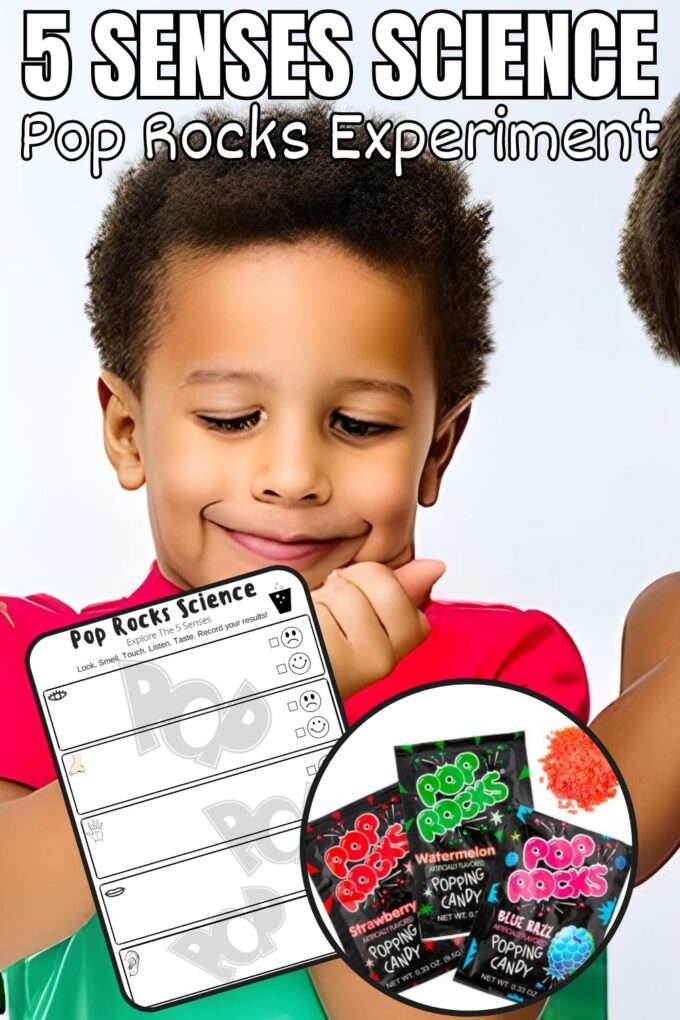
Explore Pop Rocks Science
I love to keep things simple and fun by creating hands-on science activities that are super easy and quick to set up. I also love science activities that allow kids to explore without too many guidelines!
Over the last few years we have gathered together so many awesome science experiments for preschoolers that YOU CAN DO easily at home or in a classroom. This 5 senses pop rocks experiment is definitely one of them!
Now that my son is learning how to write and enjoying writing, we have started pairing our activities with science worksheets. You can download a free worksheet below to go with this 5 senses activity!
Of course, you can also do this fun pop rocks experiment without having to write making it a perfect activity if you have multiple age kids exploring together. Make sure to get the kids talking out loud about what is going on though.
Check out here all our 5 Senses Activities For Preschoolers!
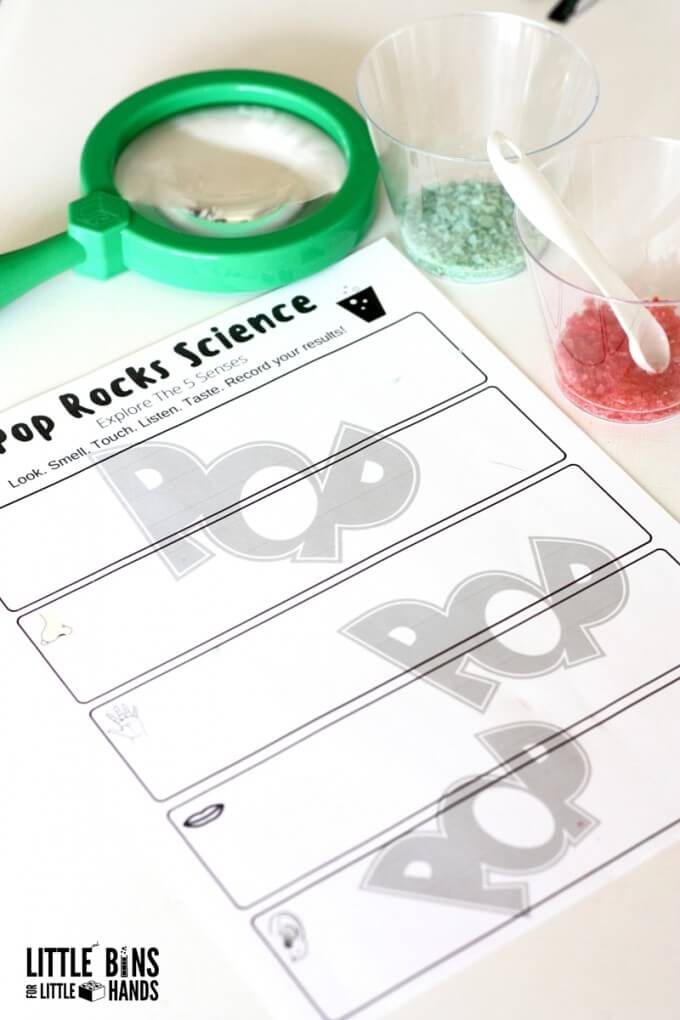
What are the 5 Senses?
If you are going to explore the 5 senses, you need to know what they are first! The 5 senses include touch, taste, sound, sight, and smell. These concepts are super easy to explore with junior scientists because we use our 5 senses every day in many ways.
The senses are how we explore and learn about the world around us. Textures and colors ignite our senses of touch and sight.
New foods and tasty goodies explore our sense of taste, even if they aren’t so tasty. Smells like peppermint or cinnamon bring back memories or make us feel more in tune with the season or holiday.
The wind rustling the leaves, the waves breaking on the shore, our footsteps walking along a wooded path, or the call of a bird overhead are fantastic opportunities for listening to our senses!
Take a look at our sensory science list to read more about combining science and sensory play as well engaging the 5 senses.
Observation and the 5 Senses
Observation in science begins with using our senses to gather information about the world around us. It involves using science process skills, paying close attention to details, making careful notes or drawings, and using tools to help us make better observations.
Making observations is an essential skill in science because it leads to collecting data and gathering evidence to support or refute hypotheses down the track. Learn more about using the scientific method with kids.
Observing is also a good way for us to explore and learn about the natural world. Young children learn when they make observations in new situations, especially with science sensory experiences.
Let’s take a closer look at how kids can practice making observations using their 5 senses:
Sight
Observing through sight involves looking closely at objects and noting their color, shape, size, and patterns. For example; start a seed jar or grow crystals!
Hearing
Observing through hearing involves listening to sounds around them and identifying their source. Kids can listen to bird songs, the rustling of leaves, or the sound of raindrops. For example; try a water xylophone!
Touch
Observe through touch to explore the texture, temperature, and hardness of objects. Kids can touch different types of materials such as sand, water, feathers, or bark. Try making oobleck or slime.
Taste
Observing through taste involves exploring the flavors of different foods or substances. They can describe the tastes as sweet, sour, bitter, or salty. Try fizzy lemonade or a Candy Taste Test!
Smell
Observing through smell involves detecting and describing odors. Kids can explore different environmental scents, such as flowers, fruits, or spices. For example; paint with spice paint!
5 Senses Pop Rocks Activity
Encourage your kids to look, smell, listen, touch, and taste the pop rocks candy. They are in for a real surprise! Science includes the senses in so many ways though usually not always taste.
Explore taste and sight with this fun does color affect taste experiment!
Supplies:
- Several packets of Pop Rocks candy (depending on number of kids)
- Cups
- Magnifying glass
- Printable 5 Senses Worksheet
How To Set Up Your Pop Rocks 5 Senses Activity:
STEP 1. Empty the pop rocks candy into cups and print out our pop rocks 5 senses worksheet to record your observations!
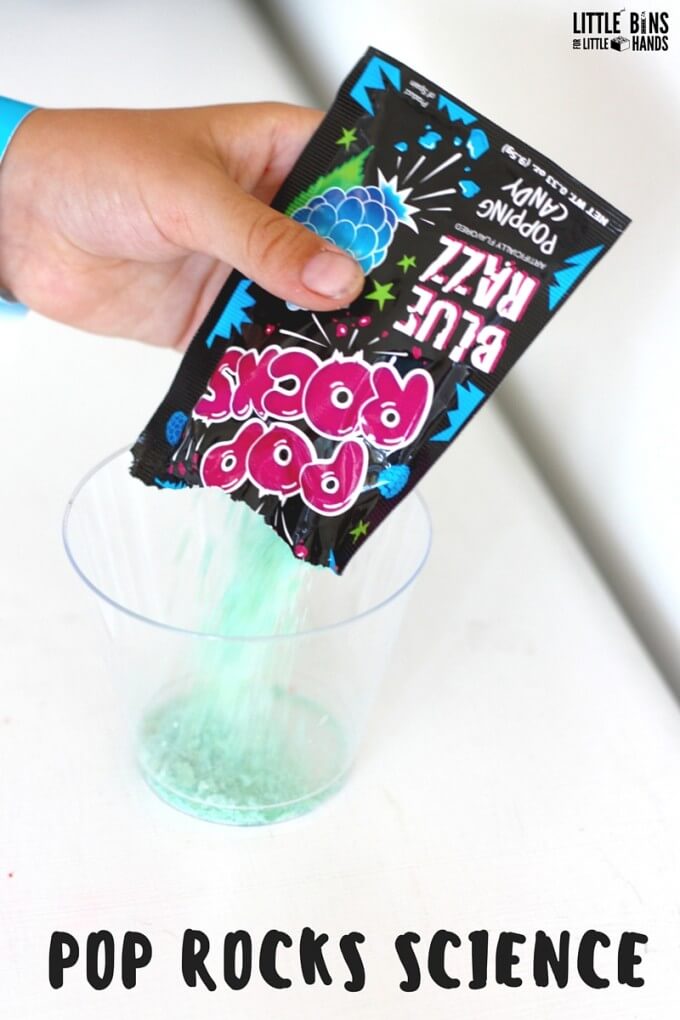
STEP 2. Ask your kids the following questions and encourage them to explore the Pop Rocks with each of their senses.
- What do you see?
- What do you smell?
- What do you hear?
- What do you feel?
- What do you taste?
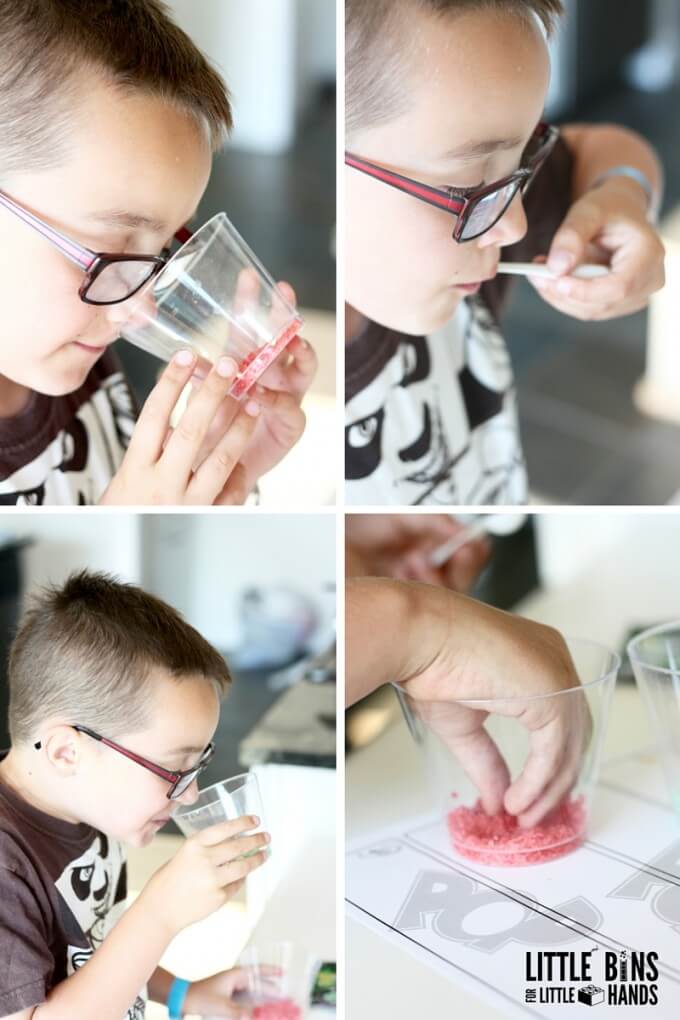
STEP 3. To extend the learning opportunity for older kids, get them to write down their observations for each of the 5 senses. This is a great opportunity for kids to practice their observation skills which is an important part of the scientific method.
Learn more about making observations in science.
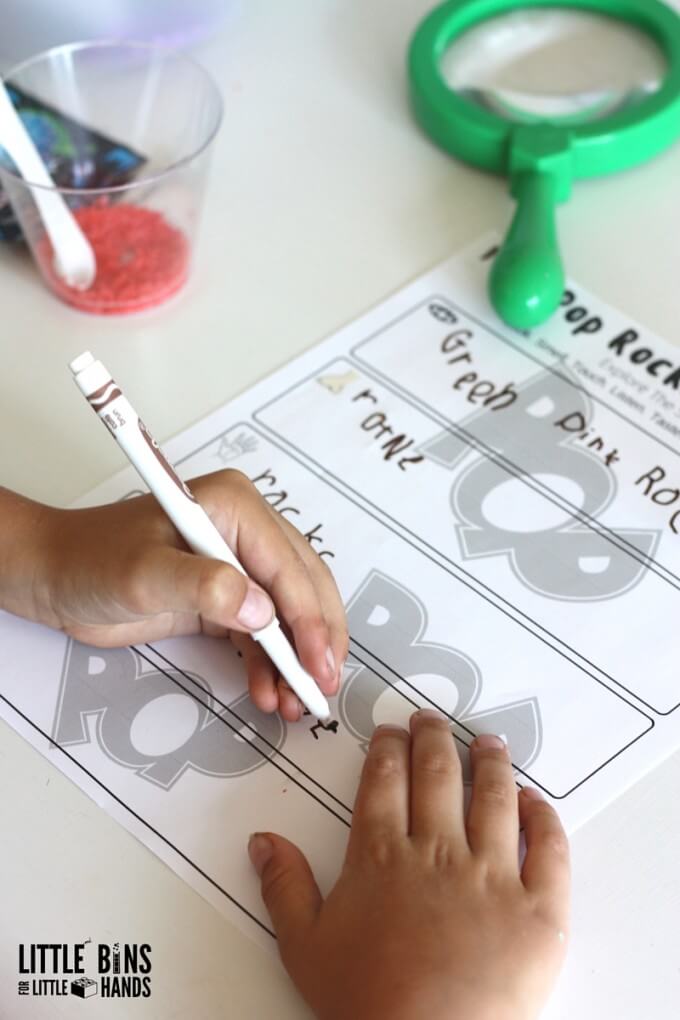
Apparently my son did not like the smell as he stated they smelled rotten! If your kids have trouble coming up with their own observations, ask some open ended questions to help point them in the right direction.
CAN YOU HEAR POP ROCKS? TEST IT OUT!
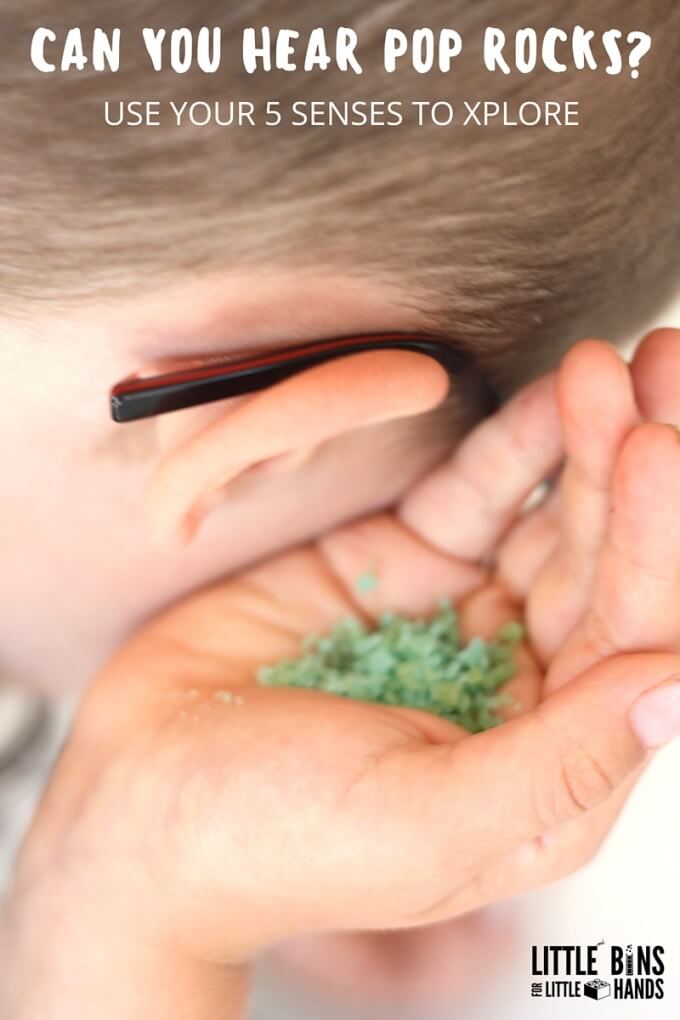
Bonus Viscosity Pop Rocks Experiment
Save some Pop Rocks for another fun Pop Rocks experiment exploring viscosity. Test whether Pop Rocks are louder when placed in liquids of different viscosity or thickness. Click here for our Pop Rocks Viscosity Experiment!
Also find out what happens when you add Pop Rocks to soda. Will the balloon inflate? Click here for our Pop Rocks and Soda Experiment.
More Fun 5 Senses Activities
Check out our complete list of 5 Senses activities or choose from one below…
- Describe an apple using the 5 senses.
- Explore 5 senses activities with a fall theme.
- Learn about the 5 senses with these simple google slides.
- Use the sense of smell with this citrus eruption.
- Find out how to set up a 5 senses sensory station.
- Explore candy with the 5 senses.
- 5 Senses Coloring Pages
- Play the 5 Senses Guess the Object game.
Printable Preschool 5 Senses Pack
Get ready to explore this year with our growing Preschool STEM Bundle! Or grab the individual Preschool 5 Senses Pack.
What’s Included:
There are 4 fun preschool themes to get you started. This is an ” I can explore” series!
Each unit contains approximately 15 activities, with instructions and templates as needed. Hands-on activities are provided to keep it fun and exciting. This includes sensory bins, experiments, games, and more! Easy supplies keep it low cost and book suggestions add the learning time.


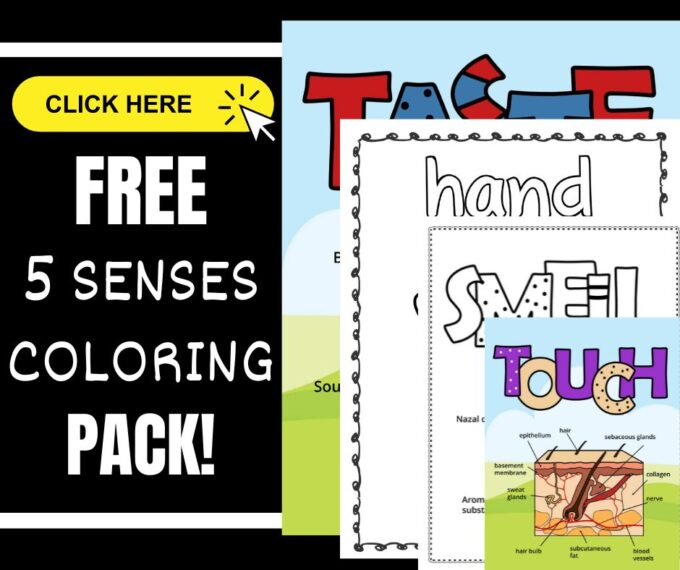
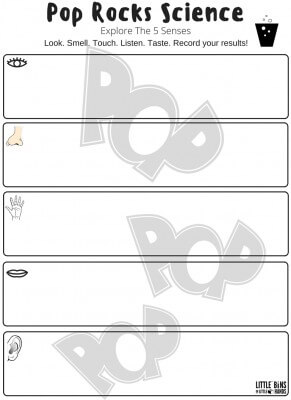
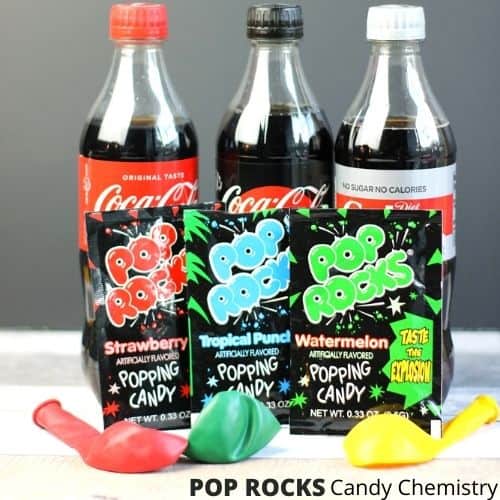
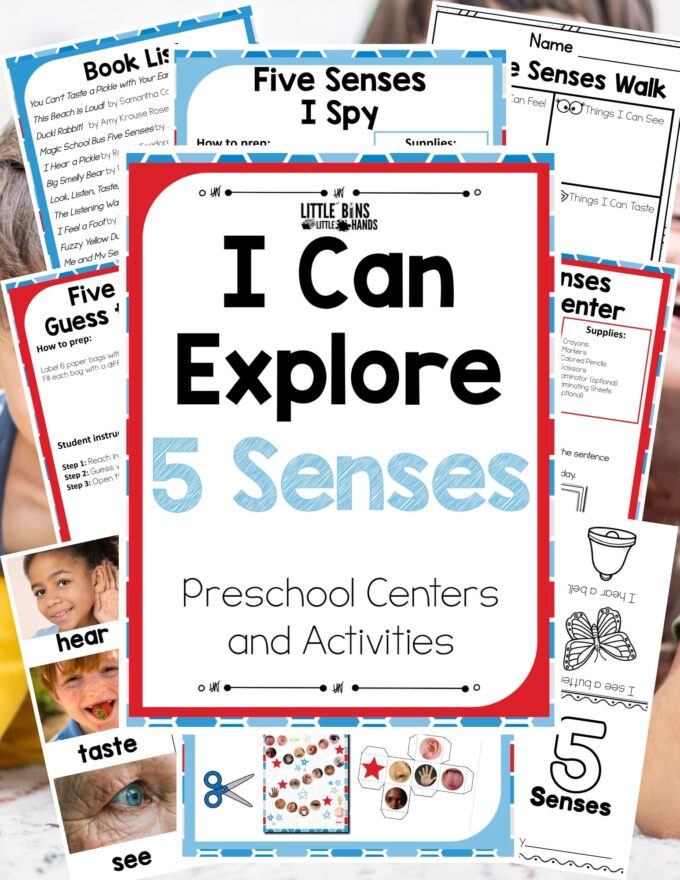






Oh my Goodness. Your website and content is AMAZING!!!! Thank you so much.